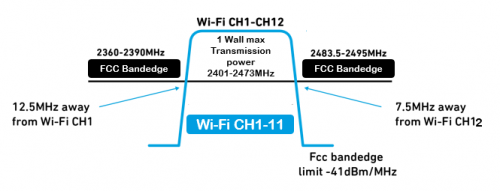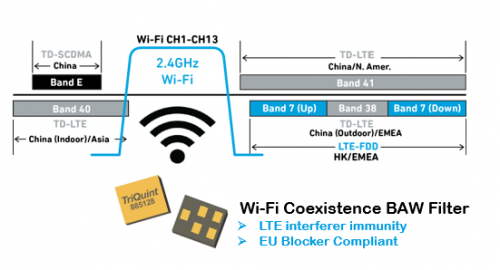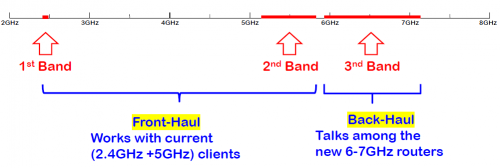Qorvo's View on WiFi 6 Opportunities and Challenges
[Copy link]
As a leading RF solution provider in the industry, Qorvo also has extensive experience in WiFi RF solutions. To this end, the Semiconductor Industry Observer reporter recently interviewed Qorvo Senior Marketing Manager Jeff Lin to share with everyone the opportunities and challenges that the new WiFi standard brings to the industry.
Changes brought by WiFi 6
When asked this question, Jeff Lin told reporters that compared with previous generations of Wi-Fi standards, Wi-Fi 6 incorporates many new technologies. The 1024QAM modulation mechanism and 160MHz bandwidth increase the connection speed; the introduction of OFDMA (Orthogonal Frequency Division Multiple Access) and MU-MIMO (Multi-User Multi-Input Multi-Output) greatly improves the efficiency of WiFi connections. In addition, WPA3 provides a safer and simpler connection encryption mechanism.
"Recently, IEEE and FCC have opened up a total of 1.2GHz bandwidth from 5.925GHz to 7.125GHz for Wi-Fi 6, and officially named this expanded frequency band Wi-Fi 6E. Together with the original 2.4GHz (2.412GHz – 2.484GHz) and 5GHz (5.15GHz – 5.825GHz), Wi-Fi 6 can use more frequency bands and channels, and has more flexibility in resource allocation," Jeff Lin continued. He further pointed out that the Wi-Fi Alliance has recently started the formulation of new specifications to standardize and accelerate the commercialization of new frequency bands.
It is these features that make WiFi 6 so attractive in the current terminal market, and many manufacturers have actively invested in it.
From Jeff Lin's introduction, we learned that Wi-Fi 6 products have been launched on the market since the end of 2018, and the product line also covers enterprise-level wireless Wi-Fi routers to home Wi-Fi Access Points. The mainstream specifications of routers have gradually been upgraded from Wi-Fi 5 to Wi-Fi 6.
"However, from the perspective of Wi-Fi terminal devices, there is no equivalent development of Wi-Fi routers and Access Points," Jeff Lin emphasized. He further pointed out that although Samsung officially introduced Wi-Fi 6 in its flagship Galaxy S10 in early 2019 and achieved a market leading position in terminal devices, it was ultimately unpopular. Many mobile phone manufacturers believed that Wi-Fi 6 routers had not yet become mainstream in the market at that time and gave up following Samsung's pace.
However, by the end of 2019, many network equipment manufacturers such as Netgear, Belkin, ASUS, TP-Link, D-Link, Xiaomi, etc. launched a series of Wi-Fi 6 wireless routers. In addition, the iPhone 11 directly incorporated 2x2 Wi-Fi 6 into the official technical specifications, and many mobile phone manufacturers began to follow suit.
"High-end mobile phones released in 2020 such as Samsung, LG, Huawei, OPPO, Vivo, and Xiaomi have all upgraded the specifications of the Wi-Fi communication part to Wi-Fi 6. Driven by the terminal equipment end, the popularity and penetration of Wi-Fi 6 will be deeper and wider in the next two years." Jeff Lin said.
What does this mean for developers?
We mentioned earlier that WiFi 6 has undergone major upgrades in bandwidth, frequency band, antenna and many other aspects. In my opinion, this will inevitably bring huge challenges to developers. Jeff Lin also agrees with this view. He pointed out that Wi-Fi 6 is a brand-new specification. Compared with Wi-Fi 5, Wi-Fi 6 has added many new technologies. Because of this, all Wi-Fi main chip suppliers and related supply chain manufacturers must develop new products based on the technical specifications of Wi-Fi 6. At the same starting point, whoever can launch Wi-Fi 6 products the fastest will be able to achieve a leading position in technology. Jeff Lin emphasized.
When it comes to RF, Jeff Lin gave an example, saying that Wi-Fi 6 incorporates many new technologies. The frequency modulation technology has been upgraded from the original OFDM to ODFMA, the modulation has also been increased from 256QAM to 1024QAM, and the number of streams has also been advanced from the earliest 1x1 to 2x2, 3x3, 4x4, and even to 8x8.
In his opinion, these upgrades return to the design level, which means that the more efficient and high-transmission-rate devices require more complex and high-specification designs. For RF developers, there are many issues that they need to consider in depth. For example, the 1024QAM modulation mechanism requires a lower EVM Floor, which requires developers to improve system design and costs such as layout, plate stacking, material selection, etc. to reduce or overcome signal interference issues; as for the introduction of MU-MIMO, the number of streams in Wi-Fi devices has increased from 2x2, 3x3, 4x4 to even 8x8. The most direct problem is the mutual interference that may be caused when different channel signals are transmitted to the receiver at the same time, and the heat dissipation caused by the overall power consumption of the multi-channel streaming system.
"Wi-Fi 6 is still in its infancy, and the relevant specifications of Wi-Fi 6E have just been released. In the context of the entire Wi-Fi 6 supply chain not yet being sound, RF developers not only have to bear greater product development pressure such as solution selection (Wi-Fi Chipsets, FEMs, Filters, Antennas...), system architecture (2x2, 3x3, 4x4 or other...), etc., but also face the challenge of high costs." said Jeff Lin.
"For different regions, there are regulations and restrictions on wireless communications, which brings problems to WiFi product design and requires developers to consider them in depth," Jeff Lin continued.
He said that the current wireless communication regulations can be classified into two types: one is the US regulation (FCC-Federal Communication Commission) and the other is the European regulation (CE-Conformité Européene). FCC allows Wi-Fi to transmit at a relatively high power, so for North America and other countries that follow FCC regulations (such as Central and South America, Taiwan, India, Singapore, Australia, etc.), high-power (High Power) front-end RF modules (FEM) are usually selected; CE has stricter specifications and more restrictions on Wi-Fi transmission power, so most Wi-Fi products that follow CE regulations use middle-power (Middle Power) front-end RF modules.
In response to these different regional regulations, Qorvo provides sideband filters and LTE-WiFi coexistence filters in addition to front-end RF modules to help developers create products with superior performance. Jeff Lin gave an example, saying that in the FCC regulations, the first and last channels of 2.4GHz (CH1 and CH11) must reduce the transmission power because CH1 and CH11 are next to the frequency band used by LTE. The FCC has this restriction to prevent the Wi-Fi 2.4GHz sideband channel from transmitting too much power and interfering with the LTE frequency band. However, for network equipment suppliers, reducing the transmission power of a specific channel will affect the coverage of Wi-Fi.
In addition, European ETSI EN 300 328 v1.8.1 has clear specifications for LTE Interferer Immunity. Since 2019, many European operators have required Wi-Fi APs to comply with EU Blocker regulations.
The above issues are the key issues that WiFi product developers need to consider.
Qorvo's response
As a leading manufacturer in the RF field, Qorvo has been engaged in early product specification formulation and technical exchanges with mainstream Wi-Fi main chip manufacturers such as Qualcomm and Broadcom more than two years ago when Wi-Fi 6 was still in the early stages of standard setting. After many improvements and design changes, Qorvo currently has corresponding middle power and high power transmission power (High Power) and 5V to 3.3V front-end RF modules (FEM) for Qualcomm and Broadcom's Wi-Fi 6 solutions and has successfully introduced the corresponding reference designs.
In addition to front-end RF modules, Qorvo also provides sideband filters (Bandedge Filter) and LTE-Wi-Fi co-existence filters (LTE Co-existence Filter) to address the different regulatory restrictions in different regions mentioned above, and can be used in conjunction with FEM.
First, let's look at the sideband filter. Jeff Lin told reporters that this Qorvo product can effectively suppress the sideband frequencies of non-Wi-Fi 2.4GHz CH1 and CH11. In addition to preventing Wi-Fi signals from interfering with LTE signal quality, it also enables all 2.4GHz channels to transmit with the same transmission power (Flat Power), ensuring that users can enjoy the best coverage and signal quality no matter which channel they use.

Bandedge filter achieves maximum transmit power in all Wi-Fi 2.4GHz channels
Looking at the LTE Co-existence filter, Jeff Lin said that Qorvo's LTE Co-existence filter can avoid interference between Wi-Fi and LTE signals.

LTE Co-existence filter reduces LTE interference to Wi-Fi while meeting EU Blocker compatibility specifications
In addition, Qorvo has also created a product line called iFEM (Integrated FEM). iFEM, as the name suggests, integrates the previously mentioned Bandedge or LTE Co-existence filter into the front-end RF module of Wi-Fi 6, which not only simplifies the design of the wireless RF front-end, but also reduces component costs and line matching adjustment time.
Thanks to the investment and accumulation in related technologies, Qorvo Wi-Fi 6 front-end RF products have been certified and incorporated into the reference designs of mainstream Wi-Fi wireless network solution chip manufacturers such as Qualcomm, Broadcom, Intel and Quantenna. According to Jeff Lin, with the help of reference designs, product developers can shorten product development time and simplify product verification work, accelerating the commercialization and shipment of Wi-Fi 6.
"At the same time, Qorvo is also working with network product developers and network service providers to participate in new network applications and architectures to further combine the concept of the Internet of Things with actual application scenarios," added Jeff Lin.
The relationship between WiFi and 5G
Entering the WiFi 6 era, especially after the launch of WiFi 6E, the speed of WiFi has made a qualitative leap, and 5G itself has also been greatly improved. There are also many discussions about the future development of these two networks. Some people even think that the two are in a substitution relationship.
In response to this question, Jeff Lin told reporters that 5G and Wi-Fi are not competing or opposing each other, but a relationship of mutual support and cooperation. This is mainly because 5G and Wi-Fi have their own advantages and disadvantages in different environments and application scenarios.
For example, the deployment of 5G must be led by telecom operators, and there will be charges for the use of frequency bands, so the overall operating cost will be much higher than Wi-Fi. Wi-Fi itself uses free open frequency bands, and the industry supply chain and product coverage are complete. In places and application scenarios within the coverage range of Wi-Fi networks, such as home networks, public areas (airports, stations, stadiums, etc.), and specific places (campuses, hotels, stores, etc.), Wi-Fi will be a more economical choice. In areas where Wi-Fi cannot cover, such as rural areas, mountainous areas, outlying islands, and other areas with low population density and weak network infrastructure, 5G networks are needed to support them.
“Currently, many solution providers and telecommunications network service operators have invested a lot of time and money in the development of 5G. However, due to the huge scale of 5G itself, the specification formulation has been subject to many policy restrictions from the beginning (such as frequency band allocation and patent competition). Coupled with the political struggles between countries (such as the Huawei case and the US-China trade war that have been a hot topic in recent days), it is undeniable that 5G faces many challenges.” Jeff Lin added.
On the other hand, Wi-Fi is the most popular wireless network technology in the world with the highest product coverage and the most key technologies are led by Wi-Fi chip providers and RF solution manufacturers. Therefore, it is much easier to introduce and deploy new technologies than 5G. Since the launch schedule of 5G and Wi-Fi 6 is similar, many people have begun to debate whether 5G will replace Wi-Fi 6.
"Based on the above analysis and the current market response to Wi-Fi 6, I personally believe that the product maturity and specification completeness of Wi-Fi 6 will be faster and more complete than 5G," said Jeff Lin.
Future prospects and challenges
Earlier in the article, we talked about how the FCC allowed WiFi to use the 6Ghz frequency band, which triggered more thoughts about the future of WiFi. How does Qorvo view this upcoming new regulation?
Jeff Lin said that Wi-Fi 6 incorporates many new technologies that greatly improve the efficiency and throughput of the connection. Currently, IEEE and Wi-Fi Alliance are working hard to incorporate the newly added 6GHz band (5925MHz-7125MHz) into the standard specifications of Wi-Fi 6. In 2019, Wi-Fi Alliance officially named this extended 6GHz band Wi-Fi 6E. In April of this year, the FCC also officially voted to allow Wi-Fi 6 to use this band. This move expanded the unlicensed band used by Wi-Fi from the original U-NII 1-3 of Wi-Fi 5 to U-NII 1-8, and the newly added 6GHz band is U-NII 5-8. The following is the frequency distribution and power limit of U-NII 5-8:

Wi-Fi 6E adds new frequency bands and power limits
In his opinion, higher frequencies and wider bandwidth support also bring many challenges to Qorvo. Qorvo is currently working closely with Wi-Fi chip providers and system vendors to develop the front-end RF modules (Front-End Modules), filters (Filters) and splitters (Diplexers) required for Wi-Fi 6E, and plans to start system verification testing by the end of 2020.
Jeff Lin pointed out that the greater bandwidth supported by Wi-Fi 6E brings unlimited imagination to network equipment manufacturers, especially for enterprise and public hotspot applications. According to his point of view, Wi-Fi 6 can solve the technical bottlenecks encountered by Wi-Fi 5, such as network congestion and uneven distribution of upload and download schedules.
“Since enterprise-level Wi-Fi Access Points and Hotspots must be able to support a large number of users connecting simultaneously and have comprehensive management of bandwidth and security, efficient connection and network service mechanisms can allow each Wi-Fi AP to connect and manage more users. WiFi 6E allows each user to enjoy a better user experience and reduces the number of Wi-Fi APs deployed based on the same coverage area,” said Jeff Lin.
He further pointed out that the newly opened frequency band of Wi-Fi 6E has the characteristics of 1.2GHz bandwidth and less interference, and some network equipment manufacturers have begun to plan to use this frequency band as a "backhaul network" between APs. He said that Wi-Fi 6 has clear definitions and descriptions of the network architecture of mesh or distributed Wi-Fi in the specifications. However, using the new frequency band defined by Wi-Fi 6E as the backhaul between APs can allow each AP to have a more stable and faster exclusive network or channel to connect to each other, thereby achieving a completely seamless connection and indoor roaming with full indoor coverage.

Using 6GHz as Backhaul to Solve Signal Coverage Issues
In Jeff Lin's view, as the Wi-Fi 6E specification is finalized, Wi-Fi network system solution providers will also upgrade the current Wi-Fi tri-band (Tri-Band) architecture from 2.4G + 5G (Low-Band) + 5G (High-Band) to 2.4G + 5G (U-NII 1-3) + 6G (U-NII 5-8).

Wi-Fi tri-band architecture based on Wi-Fi 6E
When WiFi 6 was not yet popular, the market was also full of discussions about WiFi 7. When asked about his views on this future new standard, Jeff Lin told reporters that it is not very objective to talk about Wi-Fi 7 now. After all, the entire specification of Wi-Fi 6 has not yet been perfected. The FCC just voted to open the frequency band of Wi-Fi 6E on April 23 this year. Wi-Fi RF chips, other peripherals (such as PAs, FEMs, filters, antennas) and test equipment manufacturers are beginning to develop new products in full swing to respond to the increasingly mature market and growing demand for Wi-Fi 6.
"According to market research, Wi-Fi 6 will reach more than 50% market share in 2022. I think it will be more meaningful to discuss Wi-Fi 7 at that time," said Jeff Lin.
However, there are rumors in the market that 802.11be will be the main architecture and prototype of the future Wi-Fi 7. 802.11be can support a maximum bandwidth of 320MHz, and the modulation method has been upgraded from 1024QAM of Wi-Fi 6 to 2048QAM.
Jeff Lin said that if such technical requirements are to be met, better RF chips, higher frequencies, more complete solutions and appropriate application scenarios are needed to drive them. As a leading global RF component manufacturer, Qorvo will actively participate in the early stage of specification formulation, subsequent joint development with solution providers, and then complete product mass production, testing and deployment with terminal equipment manufacturers.
| 






 提升卡
提升卡 变色卡
变色卡 千斤顶
千斤顶